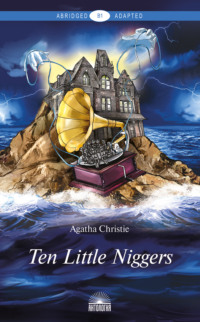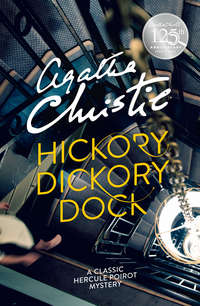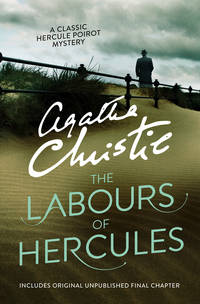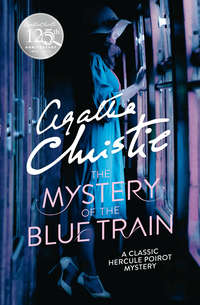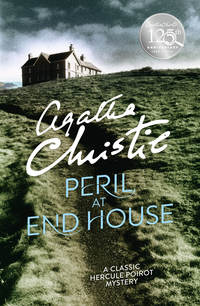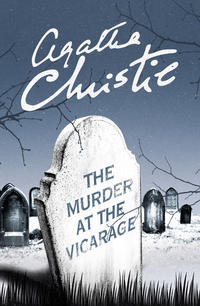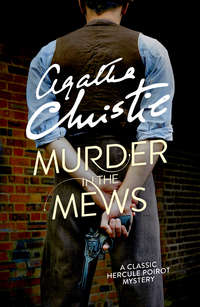
Полная версия
Hercule Poirot and the Greenshore Folly

AGATHA CHRISTIE
Hercule Poirot
and
the Greenshore Folly

Copyright
Published by HarperCollinsPublishers Ltd
1 London Bridge Street
London SE1 9GF
www.harpercollins.co.uk
First published in Great Britain by HarperCollinsPublishers Ltd 2014
Hercule Poirot and the Greenshore Folly © Mathew Prichard 2013
Foreword from Agatha Christie’s Secret Notebooks © John Curran 2009
AGATHA CHRISTIE® and POIROT® are registered trade marks of Agatha Christie Limited in the UK and/or elsewhere. All rights reserved.
www.agathachristie.com
Agatha Christie asserts the moral right to be identified as the author of this work.
A catalogue copy of this book is available from the British Library.
This novel is entirely a work of fiction. The names, characters and incidents portrayed in it are the work of the author’s imagination. Any resemblance to actual persons, living or dead, events or localities is entirely coincidental.
All rights reserved under International and Pan-American Copyright Conventions. By payment of the required fees, you have been granted the non-exclusive, non-transferable right to access and read the text of this e-book on screen. No part of this text may be reproduced, transmitted, down-loaded, decompiled, reverse engineered, or stored in or introduced into any information storage and retrieval system, in any form or by any means, whether electronic or mechanical, now known or hereinafter invented, without the express written permission of HarperCollins.
Source ISBN: 9780007546398
Ebook Edition © 2014 ISBN: 9780007546404
Version: 2017-04-11
CONTENTS
Cover
Title Page
Copyright
Introduction by Tom Adams
Preface by Mathew Prichard
Foreword
Chapter One
Chapter Two
Chapter Three
Chapter Four
Chapter Five
Chapter Six
Chapter Seven
Chapter Eight
Chapter Nine
Chapter Ten
‘Agatha Christie and The Greenshore Folly’ by John Curran
About the Author
Also by Agatha Christie
About the Publisher
Introduction by Tom Adams
MORE THAN half a century ago – 1962 to be precise – my impressively-named and enthusiastic agent, Virgil Pomfret, took me to meet the art director of Fontana Paperbacks, Patsy Cohen. On her desk was a copy of The Collector, John Fowles’ first published novel. It had been commissioned by Tony Colwell, art director at Jonathan Cape, and was my first serious attempt at trompe l’oeil painting for jacket art. It was a good time to be producing art for book covers. Good art was notably lacking in this field, particularly for paperbacks. In fact, the general standard was pretty dire, and the time was ripe for raising the bar. Up to then I had enjoyed doing serious paintings for hardback jackets, which included John Fowles’ The Magus, Patrick White’s Vivisector and David Storey’s Saville. Paperback covers were more often than not the poor second class products of publishers’ lists (with exceptions such as the original typographical Penguin covers), but virtually no serious attempt had been made to commission good art for paperbacks. However with the enthusiastic encouragement of Mark Collins, Virgil Pomfret and Patsy Cohen, I think we succeeded in doing just that.
From 1962 onwards, my relationship with Agatha Christie developed and prospered as I produced more than a hundred cover paintings for her books over twenty-five years. To begin with I simply enjoyed doing a good job. There were inevitably some failures and I know that I didn’t always please Agatha or her family. I am frequently asked if I met Agatha. I’m afraid the answer is no. Arrangements were made for various meetings; I did meet Rosalind Hicks, her daughter, Edmund Cork, her agent, and other members of her entourage, but Agatha’s legendary reticence and occasional illness prevented her from accepting invitations for us to meet. In retrospect I think it was just as well; it might have been embarrassing for both of us to discuss the likes and dislikes of various cover images. Nevertheless, for me it is a niggling regret. More recently, since my exhibition of Agatha Christie cover paintings at Torquay Museum in 2012, I have on several occasions met Mathew Prichard, a devoted and eloquent advocate of his grandmother’s achievements. Mathew and his wife Lucy have been a tower of strength and gratifyingly appreciative of my work. They helped and encouraged me in my recent endeavours on Agatha’s behalf, in particular while working on the cover painting for Hercule Poirot and the Greenshore Folly, and they arranged with the National Trust to make Greenway House and garden available for my research. Once, after a delightful lunch with Mathew and Lucy at Ferry Cottage, and with my wife, the children’s writer Georgie Adams, we were taken on a memorable boat trip on the River Dart.
I was delighted when David Brawn, Publisher of Agatha Christie at HarperCollins, asked me to do this special cover painting for a so-far unpublished story. It is a shorter version of the excellent Dead Man’s Folly and a great excuse for me to revisit Greenway. Agatha’s second husband Max Mallowan described Greenway as ‘this little paradise’, and it was for Agatha ‘the loveliest place in the world’. And it is. The handsome, foursquare, no-nonsense Georgian house is in many ways an embodiment of its famous literary owner. But it is the garden that is the true paradise. In my painting I have tried, within the constrictions of being true to the story, to embody its extraordinary beauty and magic. It is without doubt one of the iconic places of the West Country – that West Country with its rain-soaked and occasionally sun-soaked landscape, haunted moors and secret bosky woodlands, fringed by sea and rocky shores.
Greenway has a flamboyant garden, almost tropical in places and bordered by the Dart, and is now owned by the National Trust. For Agatha it provided a safe retreat from an often intrusive outside world, a world she was fascinated by and acutely observed, but into which she had no wish to be integrated.
This great detective story writer, this skilled puzzle and plot maker, was the inspiration for my work on her books. My painting for this story is a tribute to her house and garden but, nevertheless, it had to fulfil its function as an illustration. I know that Agatha instinctively disliked visual depictions of actual incidents, scenes and human figures, and in particular insisted that Hercule Poirot and Miss Marple must not be shown on the covers. Though Collins tended to adhere to these rules, her American publishers demanded more literal imagery, as demonstrated by the US version of Dead Man’s Folly, reproduced on the endpapers of this book. I have largely obeyed this sensible injunction but it is right to break rules sometimes as I have for the cover of The Greenshore Folly, in which there is some pure illustration, for instance: the house, the boathouse, the ferry bell and Battery; the magnolia (one of Agatha’s favourite flowers), the face of Lady Stubbs, the fallen oak and folly; even a slightly fantasised portrait of Agatha herself in a cherished garden nook. And there is a suggestion of a convivial crowd on the front lawn. All this is woven into what I hope is a pictorial tribute to Greenway.
Readers may note that I thatched the boathouse, as described in the story. Today it has a slate roof, but Mathew Prichard remembers it was originally thatched. So I have unwittingly restored the building to its former glory!
I make no claims to be a great artist in the same league as Francis Bacon, Lucian Freud or Graham Sutherland. Nevertheless I consider myself to be a good painter and illustrator and worthy I hope of a place somewhere in the middle of the pantheon of British 20th/21st-century art. Incidentally Graham Sutherland became a friend and mentor in the mid-fifties when I was a close neighbour in the Kentish village of Trottiscliffe. My visits to his White House studio and his to my Oast House studio were highlights of my early life as an artist. That I have been lucky enough to have survived into the 21st century and still working in my eighties is largely due to the care and loving support of my family and dear friends, not to mention great and understanding publishers and patrons, including Jonathan Cape and HarperCollins. John Fowles generously placed me in ‘one of the pleasantest traditions in English art, which goes back essentially to the great woodcut school of the 1860s; and descends through Rackham, Dulac, the Detmold brothers to our own day. Tom stands honourably in that long line …’ This is all very fine but it is the stimulation of great writers like John Fowles and Agatha Christie that inspired me in my career as an illustrator and cover artist. And I have the temerity to compare myself as an artist to Agatha as a crime novelist. Patient research and dedicated craftsmanship are key to our success. I have always thought that an infinite capacity to take pains was a somewhat inadequate definition of genius, but it is a good part of that elusive quality. Undeniably Christie had that quality, that magic ingredient. Whether or not I do is for others to decide.
Over the years I have had a growing conviction that Agatha Christie was without doubt pre-eminent as a writer of crime fiction. She was a weaver of spells, someone who leads us up and down the garden path, round and round in circles, only to deposit us in an unexpected place. Oh good heavens, we say. We didn’t see that coming! From the first words of advice she received from her friend, Eden Philpotts, Agatha learned that writing was a craft as well as an art and that there are methods and tricks for overcoming stylistic and technical obstacles.
Agatha’s work is a gift to the visual artist. Characters, locations, and objects provide a rich choice of subjects, but the lack of specific detail in her descriptions allows the illustrator to imagine and manipulate. As for imagination, Agatha had it in spades. According to Janet Morgan in Agatha Christie – A Biography, she was deeply affected by two books: J.W. Dunne’s Experiment With Time and The Mysterious Universe by Sir James Jeans, inspiring her to write to Max in 1930:
‘I understand very little of it but it fills me with nebulous ideas. How queer it would be if God were in the future – something we never created or imagined but who is not yet – supposing him to be not Cause but Effect … It’s fun to play with ideas – that God has made the world as it is and is pleased with it seems certainly not so. Originally man starved to death and froze to death (on top of coal in the ground) and every plague and pestilence caused by Man’s stupidity was put down to “God’s Will”. If life on this planet is an accident, quite unforeseen, and against all the principles of the solar system – how amazingly interesting – and when may it end? In some complete and marvellous Consciousness …’
Janet Morgan’s excellent biography discusses how Agatha was a prolific and ingenious fantasist. She ‘dreamt vividly, remembered and talked of her dreams, relished them – dreams of flying …’ I have the same propensity to fantasise and dream, especially dreams of flying, and I’ve always thought this is one of the many reasons I empathise so well with Agatha in her books.
However, Agatha was also a very down-to-earth person. Her own autobiography shows something of her humanity and wit:
‘I don’t like crowds, being jammed up against people, loud voices, noise, protracted talking, parties, and especially cocktail parties, cigarette smoke and smoking generally, any kind of drink except in cooking, marmalade, oysters, lukewarm food, grey skies, the feet of birds, or indeed the feel of a bird altogether. Final and fiercest dislike: the taste and smell of hot milk.
‘I like sunshine, apples, almost any kind of music, railway trains, numerical puzzles and anything to do with numbers, going to the sea, bathing and swimming, silence, sleeping, dreaming, eating, the smell of coffee, lilies of the valley, most dogs, and going to the theatre.
‘I could make much better lists, much grander-sounding, much more important, but there again it wouldn’t be me, and I suppose I must resign myself to being me.’
Agatha worked by herself: ‘The most blessed thing about being an author is that you do it in private and in your own time’. I profoundly echo these sentiments! My working conditions are a studio stacked with stuff, books everywhere and everything extremely untidy. I get the feeling that on the much smaller scale of a writer’s workspace Agatha was not that much more concerned with order and tidiness than I am. When asked on BBC’s radio programme, Close-Up, about her process of working, Agatha admitted: ‘The disappointing truth is that I haven’t much method’. And in John Curran’s comprehensively perceptive book, Agatha Christie’s Murder in the Making, he points out: ‘She thrived mentally on chaos, it stimulated her more than neat order; rigidity stifled her creative process.’ This was her method and it works for me too. Out of my chaos, sketches and multiple reference notes, my finished painting emerges.
Archaeology is something else Agatha and I have in common. She was married to archaeologist Sir Max Mallowan. My eldest son, Professor Jonathan Adams, is a marine archaeologist. He was Deputy Director of the excavation and raising of the Mary Rose and assembles and recreates a logical whole from an unlikely jumble of apparently unrelated bits and pieces – much as I do as an artist – and he is a fine painter. In our own ways we both share much in common with Agatha’s method of writing, and I think the processes and activities involved in archaeology are similar to the writing of detective stories: the assembly of pieces, finding facts, following clues, digging below the surface, and taking leaps of imagination …
As well as writing books, Agatha Christie was also a very accomplished playwright. My own passion for the theatre began with memories of my parents’ active life producing and acting in amateur dramatics. I was privileged to meet many of their theatrical friends such as Flora Robson and Sybil Thorndike, and I have many happy memories of being taken to theatres in London and Paris. My mother, Constance, was a pupil of Dame Carrie Tubbs at the Guildhall School of Music, though regrettably she gave up singing when she got married. Agatha trained as a singer, but she gave it up for writing.
With the painting of the new cover for Hercule Poirot and the Greenshore Folly, my association with Agatha Christie as her cover artist now exceeds fifty years. I hope that I will have the opportunity to do more. My conviction about this remarkable author that has steadily grown over the many years of our association can be summed up no better than this quote from a News Chronicle reviewer which appears in John Curran’s Agatha Christie’s Murder in the Making: ‘Mrs Christie is the greatest genius at inventing detective plots that has ever lived or will ever live’. I couldn’t put it better myself.
Tom Adams
Cornwall
January 2014
Preface by Mathew Prichard
UNUSUALLY FOR Agatha Christie, Dead Man’s Folly – the book which evolved out of this novella – was written around a specific location, in this case Greenway House on the River Dart in South Devon. Greenway was where Nima (which is what I called my grandmother) used to spend her summer holidays almost from the time she bought it in 1938 until she died in 1976. It is now 15 years since Greenway was acquired by the National Trust and subsequently opened to the public.
Last year ITV’s series Agatha Christie’s Poirot starring David Suchet shot its final film there, Dead Man’s Folly, and so a series that had begun in 1989 with The Adventure of the Clapham Cook ended in a blaze of glory at Greenway itself. Neither Nima, nor my late mother Rosalind, who had a lot to do with setting up the TV series in the beginning, could have wished for anything better. It was as if Hercule Poirot had come home.
As luck would have it, we were blessed with wonderful summer weather, and the last day of shooting in front of the house – a scene that was not in itself dramatically very significant – was none the less poignant as it featured David Suchet, in full Poirot regalia, mincing up Greenway’s front steps in his own inimitable way and knocking on the door. Eventually, after three repeats of the same action, we heard the time-honoured words – ‘it’s a wrap’ – and there was not a dry eye in the house, or rather on the lawn, where a large crowd had come to celebrate the ending of one of the world’s best loved TV series, and the portrayal of one of our best loved literary characters, Hercule Poirot, by one of our best loved character actors, David Suchet. If anyone had told Nima (who sadly never met David Suchet) that a series of this magnitude and popularity would be made continuously over a period of 25 years, I am sure that she would not have believed it.
My particular affection for Dead Man’s Folly extends back to long before the filming of the TV series, though. The book was published in 1956, when I was 13, coinciding with both the time I was beginning to enjoy reading Nima’s books, and when as a schoolboy I spent my summer holidays at Greenway with my family including, of course, Nima. I cannot say that I ever remember a fête on the lawn, but I certainly remember smaller events there, as Greenway was host to an ever-growing selection of literary and theatrical friends (this was the heyday of Nima’s career as a West End playwright), with plenty of friends of my step-grandfather Max Mallowan from the world of archaeology added for good measure. Nima never based her characters entirely on real-life people, but I would be lying if I did not admit to recognising snippets of Sir George and Lady Stubbs, and particularly Mrs Folliatt, from actual people whom she knew. Nor was I surprised when I found out that Dead Man’s Folly featured hitch-hikers. We were familiar with the occasional hitch-hiker from the nearby youth hostel called Maypool.
But I suppose Dead Man’s Folly evokes two particular memories from my childhood that I find particularly poignant: one a person, one a place. The person is Ariadne Oliver, who, although rather more boisterous than Nima would ever be, did have something of her enthusiasm, her love of apples, and a writer’s curiosity that reminds me very much of Nima herself. She appeared in seven novels, six of them with Poirot, and Zoë Wanamaker gives an excellent performance in the film. The place is the boathouse, where the poor victim is found murdered. Nima and I used to walk down to Greenway’s boathouse in the afternoon, watch the pleasure cruisers sail by (the Kiloran, Pride of Paignton, Brixham Belle and those wonderful paddle streamers, one of which I am delighted to say is still in working order). The tour guides on these boats would always refer to Greenway, usually inaccurately, as the home of Agatha Christie (rather than, strictly speaking, her holiday home), and though we could hear their voices as they sailed past, never do I remember them actually recognising her as she sat inconspicuously in the boathouse with her grandson!
As I read the book again now, I do seem to remember reading it originally on publication as a young teenager and understanding perhaps for the first time a little more about the construction of a detective story in relation to real people and real places, because I was familiar with those in this particular book. This authenticity is of course one of the reasons why Nima’s books still seem so real and convincing today. Back then, the books based around archaeology and the Middle East were pure fiction to me, although Nima used exactly the same techniques, drawing on characteristics of real people and factual landmarks and adding a fictional dimension, just as she did with Dead Man’s Folly. I hope one day that I will be able to visit Nimrud, the Pyramids in Egypt, or some other locations which inspired Nima, so that I can see them as she did. I recently visited one specific place of inspiration in Tenerife in the Canary Islands, the setting for a Harley Quin story called ‘The Man from the Sea’ (in the book The Mysterious Mr Quin) – it is a brilliant short story, and all the better for having been there.
As you probably know, my family gave Greenway to the National Trust in 1999 and it is open to the public for most of the year. Everyone can now visit the boathouse where the murder took place, or relax on a chair near where Hattie Stubbs sat and be polite to the hikers who are now allowed to enter the grounds. You may also find that the National Trust shop has the finest collection of Agatha Christie books in the West of England. Though Dead Man’s Folly is unusual in being so closely based on a real place, it is not the only Agatha Christie book that has echoes of Greenway. If you enjoy it, you should certainly read Five Little Pigs as well, with a murder on Greenway’s Battery!
Finally, one of the words I have often chosen to describe Agatha Christie’s books and films is ‘welcoming’, and I do think that Robyn Brown and Gary Calland, the two General Managers the Trust has employed since 1999, and all their staff, have surpassed themselves in making Greenway as welcoming a place as Nima did when I was young. I hope that having read this book, and maybe watched the film with David Suchet, that you can visit the original location. What a treat you have in store!
Mathew Prichard
Monmouth
January 2014
Foreword
Although it was published in November 1956, the Hercule Poirot novel Dead Man’s Folly had a complicated two-year genesis. In November 1954 Agatha Christie’s agent Hughes Massie wrote to the Diocesan Board of Finance in Exeter explaining that his client would like to see stained glass windows in the chancel of Churston Ferrers Church (Christie’s local church) and was willing to pay for them by assigning the rights of a story to a fund set up for that purpose. The Diocesan Board and the local church were both very happy with the arrangement and in a letter of 3 December 1954 Hughes Massie confirmed ‘Mrs Mallowan’s intentions to assign the magazine rights of a long short story to be entitled The Greenshore Folly’ to such a fund. The amount involved was reckoned to be in the region of £1,000 (£18,000 in today’s value).
By March 1955 the Diocesan Board was getting restive and wondering about the progress of the sale. But for the first time in 35 years, much to everyone’s embarrassment, it proved impossible to sell the story. The problem was its length; it was a long novella, which was a difficult length, neither a novel nor a short story, for the magazine market. By mid-July 1955, the decision was made to withdraw the story from sale, as ‘Agatha thinks [it] is packed with good material which she can use for her next full length novel’. As a compromise, it was agreed that she would write another short story for the Church, also to be called, for legal reasons, ‘The Greenshore Folly’, ‘though it will probably be published under some other title’. So, the original and rejected novella ‘The Greenshore Folly’ was elaborated into the novel Dead Man’s Folly and Christie wrote the shorter and similarly titled Miss Marple story ‘Greenshaw’s Folly’ to swell the coffers of the Church authorities. ‘Greenshaw’s Folly’ was first published in 1956 and was collected in The Adventure of the Christmas Pudding in 1960.




